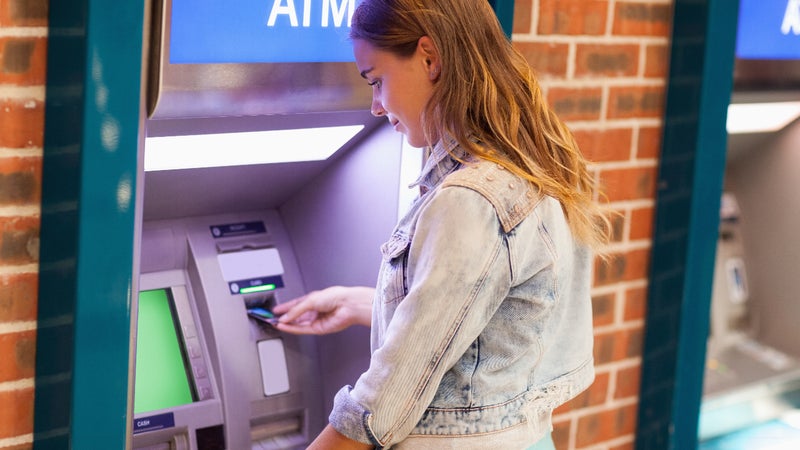What is a savings account? Definition, how they work

The Bankrate promise
At Bankrate we strive to help you make smarter financial decisions. While we adhere to strict , this post may contain references to products from our partners. Here's an explanation for .
Our writers and editors used an in-house natural language generation platform to assist with portions of this article, allowing them to focus on adding information that is uniquely helpful. The article was reviewed, fact-checked and edited by our editorial staff prior to publication.
Key takeaways
- Savings accounts are available mainly at federally-insured banks and credit unions, providing a secure means to store your money while earning a small to moderate amount of interest.
- Although many big, traditional banks offer savings accounts with paltry interest rates as low as 0.01 percent, you can find accounts with rates well above 4 percent, mostly at online-only banks and credit unions.
- While some savings accounts promote attractive rates, they may come with fees that can eat into your interest rate, which is why it’s wise to shop around for the best account for your personal financial needs.
- A federally-insured savings account that pays a modest interest rate can help you build an emergency fund, save for a major expense or grow your savings, however certificates of deposit and money market accounts may offer higher interest rates.
What is a savings account?
A savings account is a basic type of deposit account that enables you to deposit your money while typically earning a small to modest amount of interest. These accounts are federally insured for up to $250,000 per account owner, per financial institution, per ownership category at banks insured by the Federal Deposit Insurance Corp. (FDIC), or at credit unions insured by the National Credit Union Administration (NCUA). And because they’re insured, they offer a safe place to put your money while earning interest.
You can find savings accounts at banks and credit unions. Fortunately, you don’t need a large amount of money to open a savings account, and you’ll also have easy access to your money, though you may be limited by how many times you can access your money each month.
Why you need a savings account
A savings account is a good place to keep money for a later date, separate from everyday spending cash, because it offers safety, liquidity and interest-earning potential for your funds. These accounts are a great place for your emergency fund or savings for shorter-term goals, such as a vacation or home repair.
Beyond quick access to your cash when you need it, savings accounts often offer higher interest rates than checking accounts. You might even find some savings accounts with a higher annual percentage yields (APYs) than money market accounts. The average APY on savings accounts is just 0.57 percent, but you can find high-yield savings accounts paying more than 5 percent.
Finally, there are many opportunities to open a savings account with low fees. You can often find simple options to avoid pesky maintenance fees.
How does a savings account work?
You’ll open a savings account at a bank or credit union, either online or in person, similar to opening a checking account. Provide the institution with personal information and then deposit money into the account. Simple, right?
Once you’ve made a deposit, the money in your savings account will begin to earn interest. The amount earned depends on a few factors, including your savings account interest rate, APY, the amount of money you deposit and how long you keep money in your account.
Your bank may choose to compound interest on a daily, monthly, quarterly or yearly basis. At the end of each compounding period, your accrued interest is deposited into your account. From there, your new account balance (deposits plus interest) will begin earning interest.
For example, let’s say that you made an initial deposit of $10,000, and your bank compounds interest annually. With a 0.1 percent APY, you’d earn about $10 in interest for the year. However, with a high-yield savings account with an APY of 4 percent, you’d make about $400 for the year. Then, your new balance (either $10,010 or $10,400) would start to earn interest. If you have a shorter compounding period, your money will grow faster.
Keep in mind that savings account APYs are variable and can change at any time based, in part, on changes in interest rates set by the Federal Reserve. You can withdraw money out of your account whenever you want, but many institutions limit the amount of withdrawals you can make from a savings account to six per month.
How to maximize earnings from a savings account
The average interest rate on a savings account is low. Fortunately, there are a few ways to boost your earnings:
- Consider community and online-only banks: Big brick-and-mortar banks typically don’t offer the returns of these smaller institutions. Online-only banks, including challenger banks — sometimes called neobanks — tend to offer the best yields. They don’t have the costs associated with brick-and-mortar banks and pass those savings on to their customers.
- Get a sign-up bonus: Some banks offer cash bonuses when you sign up for a new savings account. These bonuses can range in the hundreds of dollars. It’s worth keeping an eye on the best bank account bonuses and signing up for an account with a great bonus and a great rate.
- Shop at credit unions: A credit union may offer you a better yield than you can find elsewhere. These not-for-profit organizations are member-owned and tend to offer high rates and low fees.
- Rely on the power of compound interest: Savings accounts offer liquidity, but your money will grow faster the less you touch it. You can use a compound interest calculator to see how small deposits into a savings account quickly add up over time.
- Watch out for fees: Some savings accounts advertise an attractive rate, but they come with fees that can eat into your interest rate. Do what you can to avoid incurring fees on your savings account. Better yet, shop for an account with very few fees.
How to open a savings account
Opening a savings account can be a straightforward task if you’re prepared. Here’s a quick checklist:
- Decide how to apply: Consider whether you want to apply online, over the phone, in person, or through the mail.
- Get your identification ready: Have your Social Security number or tax ID number handy, along with information from an official, government-issued ID such as a driver’s license or passport.
- Provide your contact information: Be ready to share your personal details such as your name, phone number, address, email as well as your date of birth.
- Decide if you’re opening an individual or joint account: Determine if the account will be solely in your name or if you’re opening it with someone else.
- Agree to the terms and conditions: Make sure you’ve read all necessary documentation about account fees, responsibilities and how your account’s interest is calculated.
- Submit your application: Send it in and wait for the bank to process your information. This may take a few days.
- Make your first deposit: Deposit money into your new account, which may need to meet a minimum amount set by the bank.
How much should you keep in your savings accounts?
The amount of money to keep in an account varies depending on your savings goals. If, for example, you’re using it as an emergency fund, most financial advisors suggest that you keep three to six months’ worth of living expenses in your account.
For example, if you spend an average of $3,000 per month on costs such as your mortgage, car payment and food, you would save anywhere from $9,000 to $18,000 in the account.
If you’re saving for a specific goal — such as a vacation, buying a house or purchasing a car — you would keep enough in the account to pay for that expense.
Consider using a savings calculator to determine how long it would take to reach a specific savings goal, based on how much you contribute to a savings account monthly.
Savings accounts advantages and disadvantages
Some of the advantages of savings accounts are:
- Safety: Money kept in a savings account at an FDIC-insured bank or an NCUA-insured credit union is insured for up to $250,000 per account owner, per financial institution, per ownership category, keeping your savings safe.
- Growth: Savings accounts are generally interest-bearing, meaning you will earn interest on the money you save in the account.
- Liquidity: Though savings accounts provide a place to stash money that is separate from your daily banking needs, they still let you make up to six withdrawals or transfers per statement cycle.
- Organization: Having savings in an account separate from your spending money makes it easier to track savings progress, curb overspending and get a better view of your overall finances.
Some of the disadvantages of savings accounts include:
- Higher yields available elsewhere: The main downside is that interest rates on savings accounts may be lower than other financial products, though other investments may come with greater risk.
- Accessibility restrictions: Most institutions restrict the number of withdrawals or transfers you can make from a savings account to six per statement cycle.
- Loss of purchasing power over time: If your savings account yield is lower than the inflation rate, you will lose purchasing power over time.
Other types of deposit products for savers
Savings accounts aren’t your only option when it comes to federally insured places to keep your money. There are other savings products offered by both banks and credit unions that are low-risk, liquid and interest-bearing.
- Money market accounts: Money market accounts can provide higher rates than savings accounts, but they may have higher minimum balance requirements. Like a savings account, withdrawals and transactions are limited to six per billing cycle. These accounts may come with an ATM card and checks.
- Certificates of deposit (CDs): CDs are time-deposit accounts. They hold your money for a specific period of time. In exchange, they pay a guaranteed fixed yield that’s generally higher than savings or money market accounts. The trade-off for the higher yield is that there’s no liquidity (without penalty) for an agreed-upon period of time, which can range from as short as a few months to as long as five years (in rare cases even longer). Unless you have a special type of CD, you’ll have to keep your money locked away for the duration of the term. If you withdraw cash early, you can get hit with a penalty that can eat up all of your interest earned and some of your principal.
FAQs
-
Yes, there are several situations where you might find your savings account balance decreasing. Bank fees such as account maintenance fees can slowly eat away at your savings, especially if you don’t meet the requirements to avoid them. Inflation can lead to a loss if the interest rate on your savings account doesn’t beat the inflation rate, thereby reducing your money’s purchasing power over time. Also, in the unlikely yet severe event that your financial institution fails, you could lose your savings if it isn’t federally insured by the FDIC or NCUA.
-
Yes, online-only accounts are generally considered safe, provided they have the same level of protection at traditional brick-and-mortar banks and credit unions, namely protected by the FDIC and NCUA, respectively. This also includes protection against cyber threats and insurance in case of bank failure.
Additionally, many online banks have implemented two-factor authentication, significantly increasing the difficulty for potential identity thieves. However, while these protections are robust, it’s important to follow standard internet safety guidelines, such as creating complex passwords, avoiding phishing scams and ensuring that you’re dealing with a legitimate institution.
– Bankrate’s René Bennett contributed to an update of this story.





